Heritage at Altitude: Navigating Moisture Challenges in Alpine Architectural Conservation
Abstract
1. Introduction
2. Materials and Methods
2.1. Thermo-Hygrometric Monitoring of the Case Studies
2.1.1. San Romerio Church, Brusio
2.1.2. Visconti-Venosta Palace, Tirano
2.1.3. Semadeni Palace, Poschiavo
2.1.4. Besta Palace, Teglio
2.2. Data Collection and Data Processing
3. Results
3.1. Monitoring of the Microclimatic Conditions
3.1.1. Mixing Ratio (MR)
3.1.2. Dew Point Depression (DPD)
3.1.3. Critical T-RH Zones
- High T (above 25 °C) + High RH (above 65%);
- Fluctuating T around 0 °C + High RH (>65%).
3.2. Probability Density Function (PDF) Analysis
PDF of the Outdoor and Indoor RH%
4. Discussion
5. Conclusions
- Prevent moisture intrusion into the structure from both the upper and lower levels of the building.
- Protect openings with shutters or other systems to minimize fluctuations caused by external weather changes.
- Avoid damage through continuous care and maintenance, prioritizing responsible, compatible, and sustained use of the building.
- Research historical techniques, materials, and habits that could enhance the physical conservation of structures and materials. Any new interventions should be rigorously tested and documented at the local scale before implementation. In many cases, unwritten sources, such as oral traditions or empirical knowledge, are equally important for documenting problem-solving techniques that remain the most sustainable and effective for conservation purposes.
Author Contributions
Funding
Data Availability Statement
Conflicts of Interest
Appendix A
| Parameter | HOBO MX1104 | HOBO U12-013 | Lascar EL-USB-2+ |
|---|---|---|---|
| Temperature | |||
| Range | −20 °C to 70 °C (−4 °F to 158 °F) | −20 °C to 70 °C (−4 °F to 158 °F) | −35 °C to 80 °C (−31 °F to 176 °F) |
| Accuracy | ±0.20° C (0 °C to 50 °C)/±0.36 °F (32 °F to 122 °F) | ±0.35 °C (0 °C to 50 °C)/±0.63 °F (32 °F to 122 °F) | ±0.45 °C typical (5 °C to 60 °C)/±1.04 °F |
| Resolution | 0.002 °C at 25 °C (0.004 °F at 77 °F) | 0.03 °C at 25 °C (0.05 °F at 77 °F) | 0.5 °C (1 °F) internal resolution |
| Long-term Drift | <0.1 °C/year (0.18 °F/year) | ±1 min/month (time accuracy at 25 °C/77 °F) | <0.02 °C/year (0.04 °F/year) |
| Relative Humidity (RH) | |||
| Range | 0% to 100% (−20 °C to 70 °C) | 5% to 95% RH | 0% to 100% RH |
| Accuracy | ±2.5% (10–90% RH, typical), max ±3.5% (incl. hysteresis at 25 °C/77 °F); ±5% (<10% or >90% RH) | ±2.5% (10–90% RH, typical), max ±3.5% (incl. hysteresis); ±5% (<10% or >90% RH) | ±3% (20–80% RH) |
| Resolution | 0.01% | 0.05% | 0.5% RH internal resolution |
| Long-term Drift | <1%/year (typical) | – | <0.25% RH/year |
| Additional Notes | Exposure >95% RH may temporarily increase max error by +1%. Operating range: −20 °C to 70 °C. Radio power: 1 mW (0 dBm). | – | Dew point accuracy (total error): 1.7 °C typical (−35 °C to 80 °C, 40–100% RH). |
| Response Time | |||
| Temperature | 11 min (90% in moving air at 1 m/s) | 6 min (90% in moving air at 1 m/s) | – |
| RH | 30 s (90% in moving air at 1 m/s) | 1 min (90% in moving air at 1 m/s) | – |
| Data Capacity | – | 16,382 readings (T/RH) | – |
References
- Mazzadi, F.; Lab, C. Towards the regeneration of mountain tourism territories. Insights from the Alta Valtellina region. Riv. Geogr. Ital. 2024, 22, 114–131. [Google Scholar]
- Berro, D.C. Le Alpi nel 2050: Clima e territorio. Arch. Alp. 2023, 9, 1–15. [Google Scholar]
- Spiridonov, V.; Ćurić, M.; Novkovski, N. The New Era of Environmental Monitoring: Insights into Weather, Water, and Climate. Atmos. Perspect. 2025, 1, 401–443. [Google Scholar]
- Xu, H.; Duan, Y.; Xu, X. Exploring the integration of a global AI model with traditional data assimilation in weather forecasting. Environ. Res. Lett. 2024, 19, 124079. [Google Scholar] [CrossRef]
- World Meteorological Organization (WMO). Manual on Codes. Available online: https://library.wmo.int/idurl/4/35713 (accessed on 23 June 2025).
- Fatorić, S.; Seekamp, E. Are cultural heritage and resources threatened by climate change? A systematic literature review. Clim. Chang. 2017, 142, 227–254. [Google Scholar] [CrossRef]
- Palazzi, E.; von Hardenberg, J.; Terzago, S.; Provenzale, A. Precipitation in the Karakoram-Himalaya: A CMIP5 view. Clim. Dyn. 2015, 45, 21–45. [Google Scholar] [CrossRef]
- Rangwala, I.; Palazzi, E.; Miller, J.R. Projected Climate Change in the Himalayas during the Twenty-First Century. In Himalayan Weather and Climate and Their Impact on the Environment; Springer: Cham, Switzerland, 2020; pp. 51–71. [Google Scholar]
- Rosina, E.; Zala, M. The microclimates unbalance of subterrain historic spaces in Italy. In Proceedings of the Conference on Cultural Heritage, Milan, Italy, 20-22 September 2023; pp. 247–252. [Google Scholar]
- Rosina, E.; Zala, M.; Ammendola, A. The moisture issue affecting the historical buildings in the Po valley. In Proceedings of the Heritage Conservation Symposium, Trieste, Italy, 15 June 2023; pp. 285–290. [Google Scholar]
- Rose Marco, D.; Caccamo, M.T.; Casale, F.; Bocchiola, D. Climate Change Effects upon Pasture in the Alps: The Case of Valtellina Valley, Italy. Climate 2022, 10, 173. [Google Scholar] [CrossRef]
- Bonari, G.; Bricca, A.; Tomasi, G.; Dorigatti, L.; Bertolli, A.; Andreatta, D.; Sabatini, F.M.; Di Musciano, M.; Prosser, F. Grassland Changes in the Eastern Alps Over Four Decades: Unveiling Patterns Along an Elevation Gradient. Appl. Veg. Sci. 2025, 28, e70012. [Google Scholar] [CrossRef]
- Cacciotti, R.; Sardella, A.; Drdácký, M.; Bonazza, A. A Methodology for Vulnerability Assessment of Cultural Heritage in Extreme Climate Changes. Int. J. Disaster Risk Sci. 2024, 15, 404–420. [Google Scholar] [CrossRef]
- Choidis, P.; Coelho, G.B.A.; Kraniotis, D. Assessment of frost damage risk in a historic masonry wall due to climate change. Adv. Geosci. 2023, 58, 157–175. [Google Scholar] [CrossRef]
- Cavargna-Sani, M.; Epard, J.L.; Steck, A. Structure, geometry and kinematics of the northern Adula nappe (Central Alps). Swiss J. Geosci. 2014, 107, 135–156. [Google Scholar] [CrossRef]
- Klostermann, J.; van de Sandt, K.; Harley, M.; Hildén, M.; Leiter, T.; van Minnen, J.; Pieterse, N.; van Bree, L. Towards a framework to assess, compare and develop monitoring and evaluation of climate change adaptation in Europe. Mitig. Adapt. Strateg. Glob. Chang. 2018, 23, 187–209. [Google Scholar] [CrossRef] [PubMed]
- Mahdjoubi, L.; Hawas, S.; Fitton, R.; Dewidar, K.; Nagy, G.; Marshall, A.; Alzaatreh, A.; Abdelhady, E. A Guide for Monitoring the Effects of Climate Change on Heritage Building Materials and Elements. Available online: https://uwe-repository.worktribe.com/output/882571 (accessed on 23 June 2025).
- Elmi, M. The Alps in 25 Maps; Permanent Secretariat of the Alpine Convention: Innsbruck, Austria, 2018. [Google Scholar]
- Interreg Alpine Space Programme—Alpine Space Programme. Available online: https://www.alpine-space.eu/ (accessed on 23 June 2025).
- Progetti Finanziati. Available online: https://www.interreg-italiasvizzera.eu/wps/portal/site/interreg-italia-svizzera/progetti/progetti-finanziati (accessed on 19 July 2025).
- Sardella, A.; Palazzi, E.; von Hardenberg, J.; Del Grande, C.; De Nuntiis, P.; Sabbioni, C.; Bonazza, A. Risk Mapping for the Sustainable Protection of Cultural Heritage in Extreme Changing Environments. Atmosphere 2020, 11, 700. [Google Scholar] [CrossRef]
- Padeletti, G. Heritage Resilience Against Climate Events on Site—HERACLES Project: Mission and Vision. In Communications in Computer and Information Science; Springer: Cham, Switzerland, 2019; Volume 961, pp. 360–375. [Google Scholar]
- Kalamees, T.; Väli, A.; Kurik, L.; Napp, M.; Arümagi, E.; Kallavus, U. The influence of indoor climate control on risk for damages in naturally ventilated historic churches in cold climate. Int. J. Archit. Herit. 2016, 10, 486–498. [Google Scholar] [CrossRef]
- Sciurpi, F.; Carletti, C.; Cellai, G.; Pierangioli, L. Environmental monitoring and microclimatic control strategies in ‘La Specola’ museum of Florence. Energy Build. 2015, 95, 190–201. [Google Scholar] [CrossRef]
- Aste, N.; Adhikari, R.; Buzzetti, M.; Della Torre, S.; Del Pero, C.; Huerto, H.E.; Leonforte, F. Microclimatic monitoring of the Duomo (Milan Cathedral): Risks-based analysis for the conservation of its cultural heritage. Build. Environ. 2019, 148, 240–257. [Google Scholar] [CrossRef]
- Bonazza, A.; Sardella, A. Climate Change and Cultural Heritage: Methods and Approaches for Damage and Risk Assessment Addressed to a Practical Application. Heritage 2023, 6, 3578–3589. [Google Scholar] [CrossRef]
- Sesana, E.; Gagnon, A.S.; Bonazza, A.; Hughes, J.J. An integrated approach for assessing the vulnerability of World Heritage Sites to climate change impacts. J. Cult. Herit. 2020, 41, 211–224. [Google Scholar] [CrossRef]
- Andretta, M.; Coppola, F.; Seccia, L. Investigation on the interaction between the outdoor environment and the indoor microclimate of a historical library. J. Cult. Herit. 2016, 17, 75–86. [Google Scholar] [CrossRef]
- Leissner, J.; Kilian, R.; Kotova, L.; Jacob, D.; Mikolajewicz, U.; Brostrom, T.; Ashley-Smith, J.; Schellen, H.L.; Martens, M.; Van Schijndel, J.; et al. Climate for culture: Assessing the impact of climate change on the future indoor climate in historic buildings using simulations. Herit. Sci. 2015, 3, 38. [Google Scholar] [CrossRef]
- Haugen, A.; Bertolin, C.; Leijonhufvud, G.; Olstad, T.; Broström, T. A Methodology for Long-Term Monitoring of Climate Change Impacts on Historic Buildings. Geosciences 2018, 8, 370. [Google Scholar] [CrossRef]
- Rosina, E.; Zala, M.; Ammendola, A. The moisture issue affecting the historical buildings in the Alps region. In Proceedings of the NDT Conference, Brescia, Italy, 28–30 November 2023; Available online: https://www.ndt.net/?id=28944 (accessed on 23 June 2025).
- Rosina, E.; Zala, M.; Pecoraro, I.; Romoli, E.; Pili, A. Il ruolo del monitoraggio microclimatico per la conservazione del patrimonio storico diffuso, dalle Alpi al Mediterraneo. In Restauro Dell’architettura. Per un Progetto di Qualità; SIRA: Napoli, Italy, 2023. [Google Scholar]
- Ludwig, N.; Rosina, E.; Sansonetti, A. Evaluation and monitoring of water diffusion into stone porous materials by means of innovative IR thermography techniques. Measurement 2018, 118, 348–353. [Google Scholar] [CrossRef]
- Thickett, D. Comparison of Environmental Control Strategies for Historic Buildings. Stud. Conserv. 2020, 65, 314–320. [Google Scholar] [CrossRef]
- UNEP; Adger, N.; Aggarwal, P.; Agrawala, S.; Alcamo, J.; Allali, A.; Anisimov, O.; Arnell, N.; Boko, M.; Canziani, O.; et al. Climate Change 2007: Impacts, Adaptation and Vulnerability. Available online: https://msuweb.montclair.edu/~lebelp/PSC643IntPolEcon/IPCCClimateChange2007.pdf (accessed on 26 February 2025).
- Huerto-Cardenas, H.E.; Aste, N.; Del Pero, C.; Della Torre, S.; Leonforte, F. Effects of Climate Change on the Future of Heritage Buildings: Case Study and Applied Methodology. Climate 2021, 9, 132. [Google Scholar] [CrossRef]
- Melada, J. Microclimate and Heritage Conservation: Probabilistic Damage Functions as Risk Assessment Tools. Available online: https://air.unimi.it/handle/2434/1070048 (accessed on 23 June 2025).
- Urbina Leonor, L.M.; Echeverría, R.S.; Perez, N.A.; Vega, E.; Kahl, J.D.W.; Murillo, M.S.; Ayala, R.S. Importance of Atmospheric Sciences in Stone Heritage Conservation Study in Italy and Mexico. Sustainability 2023, 15, 5321. [Google Scholar] [CrossRef]
- Isaksson, T.; Thelandersson, S.; Ekstrand-Tobin, A.; Johansson, P. Critical conditions for onset of mould growth under varying climate conditions. Build. Environ. 2010, 45, 1712–1721. [Google Scholar] [CrossRef]
- Loli, A.; Bertolin, C. Indoor Multi-Risk Scenarios of Climate Change Effects on Building Materials in Scandinavian Countries. Geosciences 2018, 8, 347. [Google Scholar] [CrossRef]
- Lisø, K.R.; Hygen, H.O.; Kvande, T.; Thue, J.V. Decay potential in wood structures using climate data. Build. Res. Inf. 2006, 34, 546–551. [Google Scholar] [CrossRef]
- Grøntoft, T. Observed Recent Change in Climate and Potential for Decay of Norwegian Wood Structures. Climate 2019, 7, 33. [Google Scholar] [CrossRef]
- Rosina, E. When and how reducing moisture content for the conservation of historic building. A problem solving view or monitoring approach? J. Cult. Herit. 2018, 31, S82–S88. [Google Scholar] [CrossRef]
- Kaslegard, A.S. Climate Change and Cultural Heritage in the Nordic Countries; Nordic Council of Ministers: Copenhagen, Denmark, 2011. [Google Scholar]
- Barreira, E.; Almeida, R.M.S.F. IRT Versus Moisture: In Situ Tests in Indoor Environment. In SpringerBriefs in Applied Sciences and Technology; Springer: Cham, Switzerland, 2019; pp. 43–51. [Google Scholar]
- UNI. UNI 10829:1999—Beni di Interesse Storico e Artistico—Condizioni Ambientali di Conservazione—Misurazione ed Analisi. Available online: https://store.uni.com/uni-10829-1999 (accessed on 23 June 2025).
- UNI. UNI 11085:2003—Cultural Heritage—Natural and Artificial Stones—Moisture Content Determination: Gravimetric Method. Available online: https://store.uni.com/en/uni-11085-2003 (accessed on 23 June 2025).
- UNI. UNI EN 13187:2000—Prestazione Termica Degli Edifici—Rivelazione Qualitativa Delle Irregolarità Termiche Negli Involucri Edilizi—Metodo All’infrarosso. Available online: https://store.uni.com/uni-en-13187-2000 (accessed on 23 June 2025).
- UNI. UNI EN 16714-1:2016—Prove non Distruttive—Prove Termografiche—Parte 1: Principi Generali. Available online: https://store.uni.com/uni-en-16714-1-2016 (accessed on 23 June 2025).
- ASHRAE. ASHRAE Guideline 34-2019, Energy Guideline for Historic Buildings. Available online: https://www.ashrae.org/about/news/2019/ashrae-publishes-new-guideline-on-energy-efficiency-for-historic-buildings (accessed on 23 June 2025).
- UNI. UNI EN 15757:2010—Conservazione dei Beni Culturali—Specifiche Concernenti la Temperatura e L’umidità Relativa per Limitare I Danni Meccanici Causati dal Clima ai Materiali Organici Igroscopici. Available online: https://store.uni.com/uni-en-15757-2010 (accessed on 23 June 2025).
- Pretelli, M.; Fabbri, K. Historic Indoor Microclimate of the Heritage Buildings; Springer: Cham, Switzerland, 2018. [Google Scholar]
- Franzoni, E. Rising damp removal from historical masonries: A still open challenge. Constr. Build. Mater. 2014, 54, 123–136. [Google Scholar] [CrossRef]
- Bison, P.; Cadelano, G.; Capineri, L.; Capitani, D.; Casellato, U.; Faroldi, P.; Grinzato, E.; Ludwig, N.; Olmi, R.; Priori, S.; et al. Limits and advantages of different techniques for testing moisture content in masonry. Mater. Eval. 2011, 69, 111–116. [Google Scholar]
- Rosina, E.; Ludwig, N.; Della Torre, S.; D’Ascola, S.; Sotgia, C.; Cornale, P. Thermal and Hygroscopic Characteristics of Restored Plasters with Different Surface Textures. Mater. Eval. 2016, 66, 1271–1278. [Google Scholar]
- Sansonetti, A.; Casati, M.; Rosina, E.; Gerenzani, F.; Gondola, M.; Ludwig, N. Contribution of IR Thermography to the Performance Evaluation of Water Repellent Treatments. Restor. Build. Monum. 2012, 18, 13–22. [Google Scholar] [CrossRef]
- UNI 10586:1997; Beni Culturali—Condizioni Climatiche per Ambienti di Conservazione di Documenti Grafici e Caratteristiche Degli Involucri. Ente Nazionale Italiano di Unificazione (UNI): Milano, Italy, 1997.
- UNI 10969:2002; Beni Culturali—Materiali Lapidei Naturali ed Artificiali—Descrizione della Forma di Alterazione—Termini e Definizioni. Ente Nazionale Italiano di Unificazione (UNI): Milano, Italy, 2002.
- UNI 9252:1988; Isolamento Termico. Rilievo e Analisi Qualitativa delle Irregolarità Termiche negli Involucri Degli Edifici. Metodo della Termografia All’infrarosso. Ente Nazionale Italiano di Unificazione (UNI): Milano, Italy, 1988.
- Ricci, M.; Laureti, S.; Malekmohammadi, H.; Sfarra, S.; Melis, M.; Agresti, G.; Lanteri, L.; Colantonio, C.; Calabro, G.; Pelosi, C. Multi-spectral and Thermography Imaging Techniques for the Investigation of a 15th Century Wall Painting. Res. Sq. 2020. [Google Scholar] [CrossRef]
- Nguyen, J.L.; Schwartz, J.; Dockery, D.W. The relationship between indoor and outdoor temperature, apparent temperature, relative humidity, and absolute humidity. Indoor Air 2014, 24, 103–112. [Google Scholar] [CrossRef]
- Coley, D.; Kershaw, T. Changes in internal temperatures within the built environment as a response to a changing climate. Build. Environ. 2010, 45, 89–93. [Google Scholar] [CrossRef]
- Rosina, E.; Sansonetti, A. San Rocco Church: A Typical Ancient Structure in Northern Italy. Mater. Eval. 2011, 69, 32–40. [Google Scholar]
- Phillips, H. The capacity to adapt to climate change at heritage sites—The development of a conceptual framework. Environ. Sci. Policy 2015, 47, 118–125. [Google Scholar] [CrossRef]
- Carroll, P.; Aarrevaara, E. Review of Potential Risk Factors of Cultural Heritage Sites and Initial Modelling for Adaptation to Climate Change. Geosciences 2018, 8, 322. [Google Scholar] [CrossRef]
- Forino, G.; MacKee, J.; von Meding, J. A proposed assessment index for climate change-related risk for cultural heritage protection in Newcastle (Australia). Int. J. Disaster Risk Reduct. 2016, 19, 235–248. [Google Scholar] [CrossRef]
- Franzoni, E.; Berk, B.; Bassi, M.; Marrone, C. An integrated approach to the monitoring of rising damp in historic brick masonry. Constr. Build. Mater. 2023, 370, 130631. [Google Scholar] [CrossRef]
- Monteith, J.L.; Unsworth, M.H. Properties of Gases and Liquids. In Principles of Environmental Physics; Academic Press: Cambridge, MA, USA, 2013; pp. 5–23. [Google Scholar]
- Camuffo, D. Humidity and Conservation. In Microclimate for Cultural Heritage; Elsevier: Amsterdam, The Netherlands, 2014; pp. 77–118. [Google Scholar]
- Menneer, T.; Mueller, M.; Sharpe, R.; Townley, S. Modelling mould growth in domestic environments using relative humidity and temperature. Build. Environ. 2022, 207, 108440. [Google Scholar] [CrossRef]
- Viitanen, H.; Vinha, J.; Salminen, K.; Ojanen, T.; Peuhkuri, R.; Paajanen, L.; Lähdesmäki, K. Moisture and bio-deterioration risk of building materials and structures. J. Build. Phys. 2010, 33, 201–224. [Google Scholar] [CrossRef]
- Yu, D.; Klein, S.; Reindl, D. An Evaluation of Silica Gel for Humidity Control in Display Cases. Available online: https://cool.culturalheritage.org/waac/wn/wn23/wn23-2/wn23-206.html (accessed on 25 June 2025).
- Camuffo, D.; Bertolin, C. Towards standardisation of moisture content measurement in cultural heritage materials. e-Preserv. Sci. 2012, 9, 1–6. [Google Scholar]
- Califano, A.; Baiesi, M.; Bertolin, C. Analysing the Main Standards for Climate-Induced Mechanical Risk in Heritage Wooden Structures: The Case of the Ringebu and Heddal Stave Churches (Norway). Atmosphere 2022, 13, 791. [Google Scholar] [CrossRef]
- Dolińska, N.; Wojciechowska, G.; Bednarz, Ł. Monitoring Environmental and Structural Parameters in Historical Masonry Buildings Using IoT LoRaWAN-Based Wireless Sensors. Buildings 2025, 15, 282. [Google Scholar] [CrossRef]
- Pinheiro, V.R.F.; Fontenele, R.; Magalhães, A.; Frota, N.; Mesquita, E. Evaluation of the influence of climatic changes on the degradation of the historic buildings. Energy Build. 2024, 323, 114813. [Google Scholar] [CrossRef]
- Esteban-Cantillo, O.J.; Menendez, B.; Quesada, B. Climate change and air pollution impacts on cultural heritage building materials in Europe and Mexico. Sci. Total Environ. 2024, 921, 170945. [Google Scholar] [CrossRef]
- Cano, H.; Ríos-Rojas, J.F.; Hernández-Fernández, J.; Herrera, W.B.; Betancur, M.B.; Vélez, L.D.L.H.; González, L.A. Impact of Environmental Pollution in the Sustainability of Architectural Heritage: Case Study from Cartagena of India, Colombia. Sustainability 2022, 14, 189. [Google Scholar] [CrossRef]
- Lobarinhas, R.; Dionísio, A.; Paneiro, G. High Temperature Effects on Global Heritage Stone Resources: A Systematic Review. Heritage 2024, 7, 6310–6342. [Google Scholar] [CrossRef]
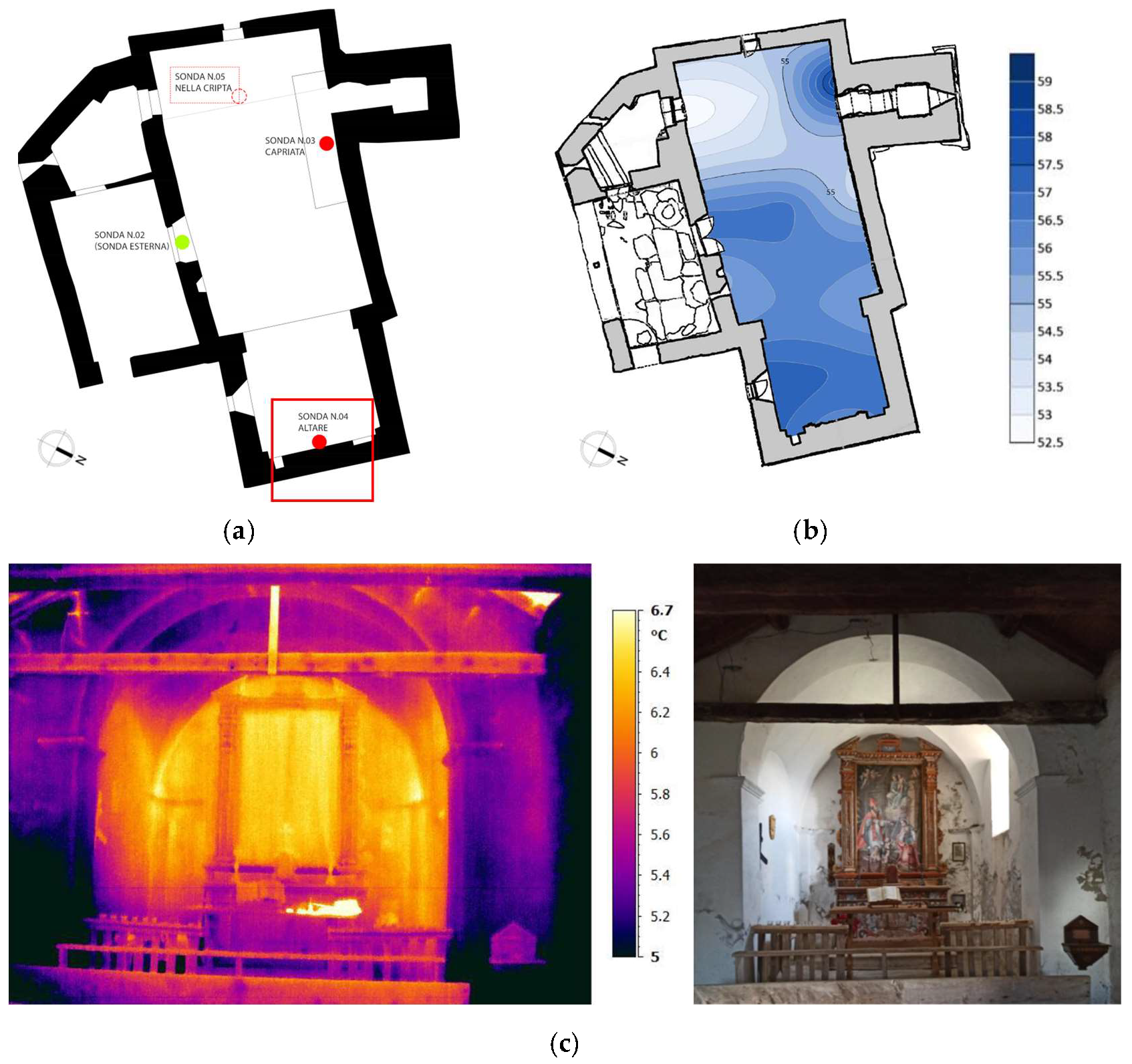



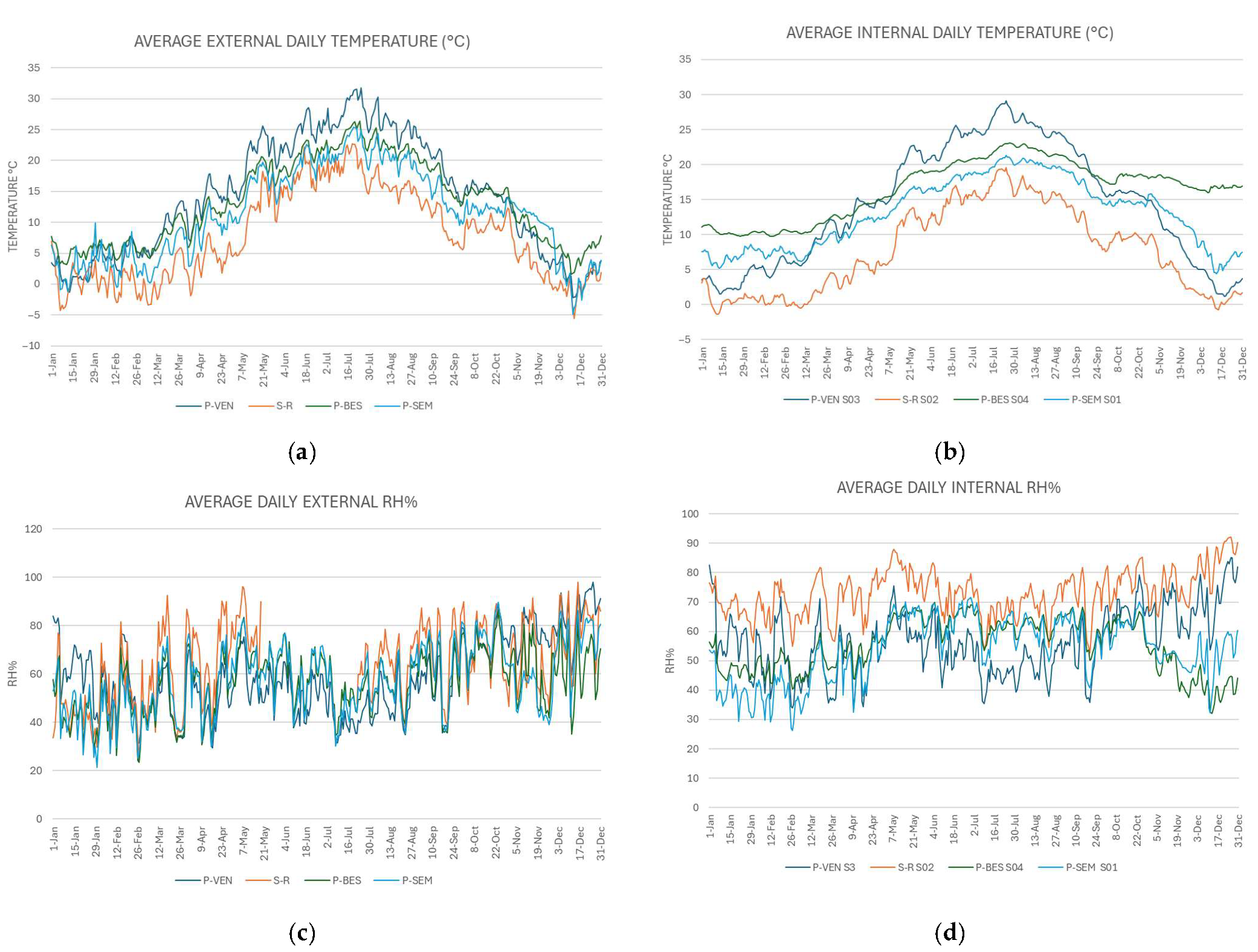

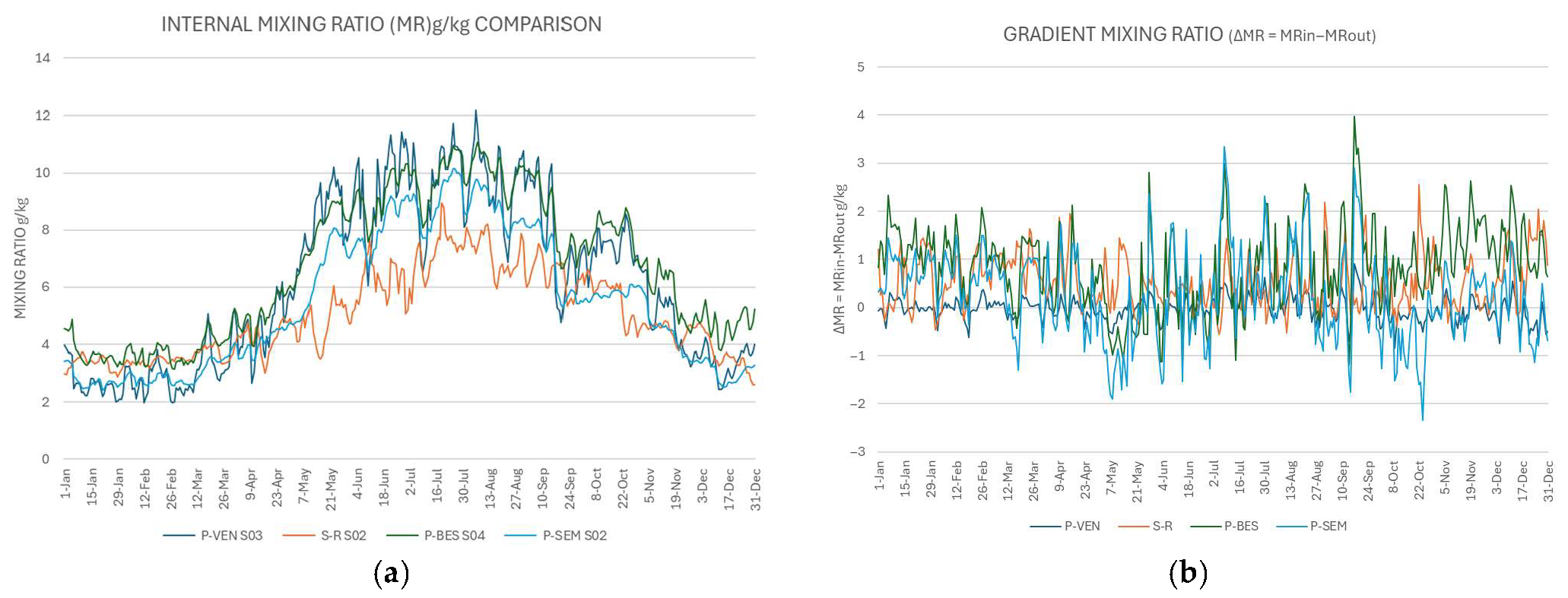
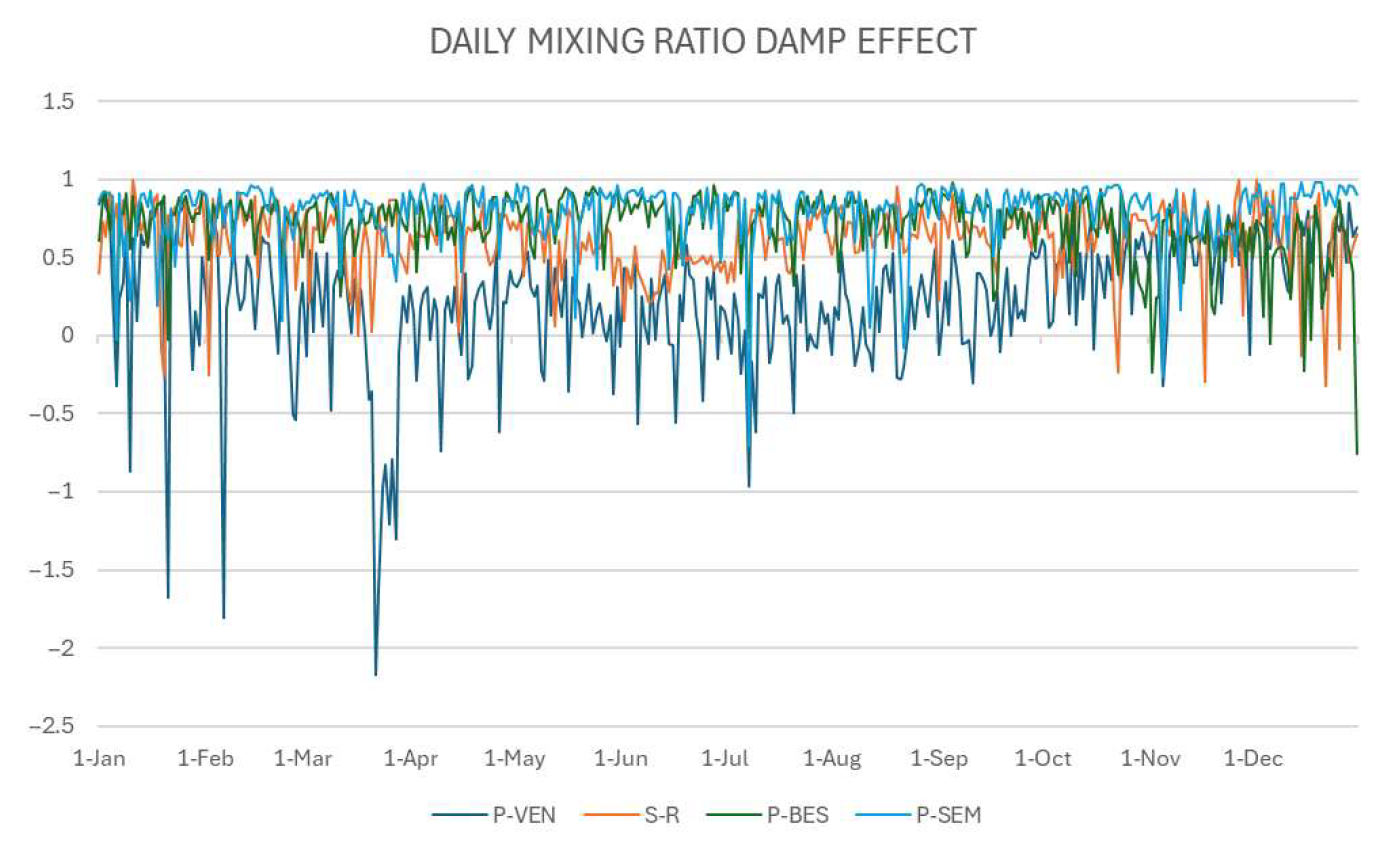


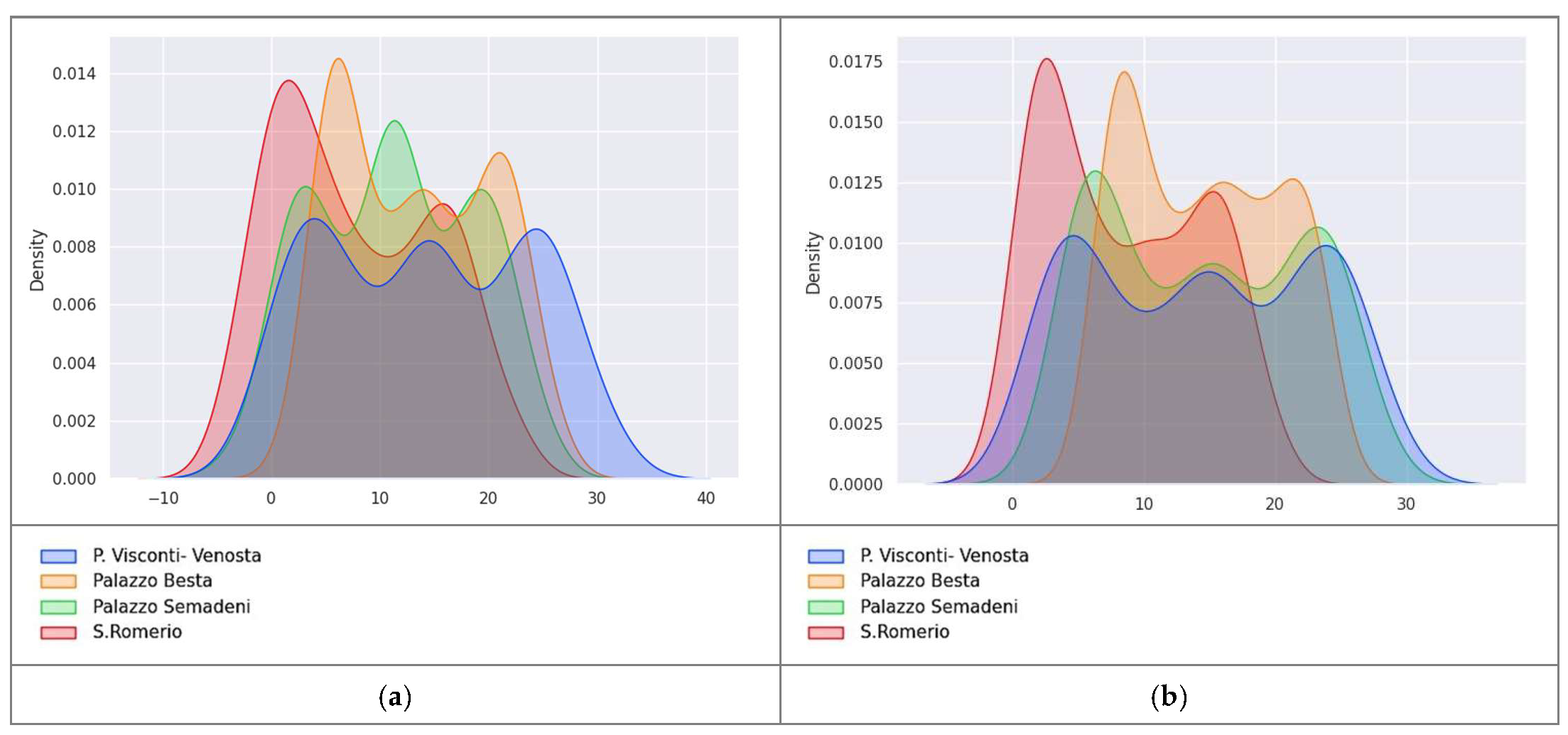
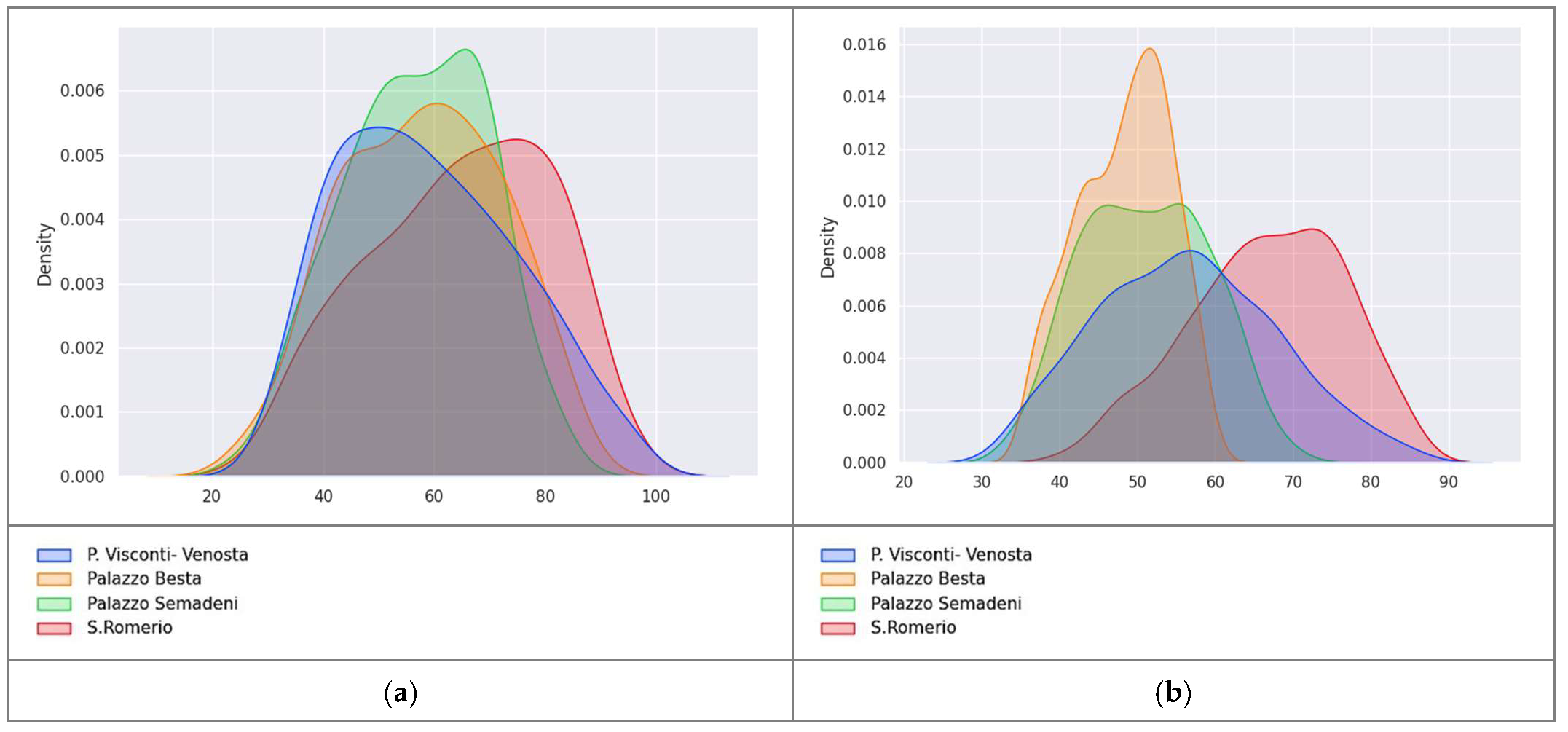
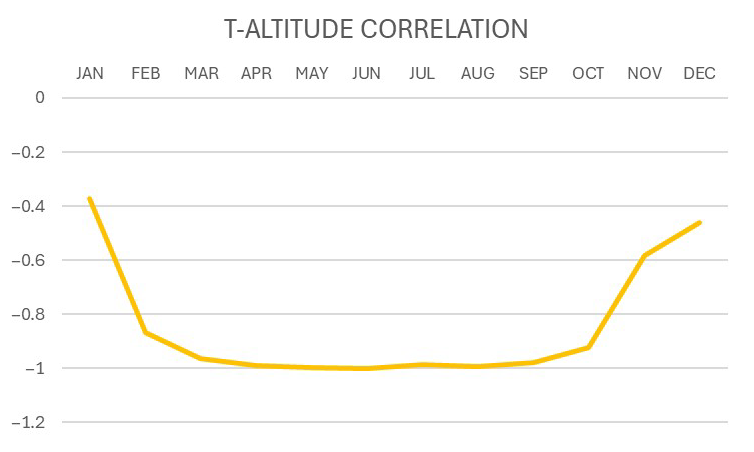
| Characteristics | Visconti-Venosta Palace (P-VEN) | Semadeni Palace (P-SEM) | Besta Palace (P_BES) | San Romerio Church (S-R) |
|---|---|---|---|---|
| image | 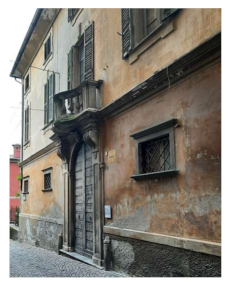 | 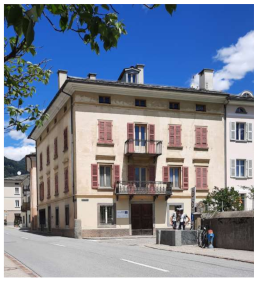 | 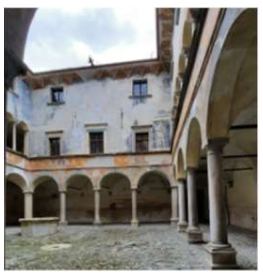 |  |
| Geographic location | Via Visconti Venosta, 2A, 23037 Tirano SO | Via da Mezz 53, 7742 Poschiavo, Switzerland | V. Fabio Besta, 8, 23036 Teglio SO | Alpe San Romerio, 7743 Brusio, Switzerland |
| Building Materials | stone masonry | stone masonry | stone masonry | stone masonry |
| Construction date | 15–18th century | 19th century | 15th century | 17th century |
| Building use | not in use | not in use | some visitors in summer | seldom used, only in summer-autumn |
| Elevation level | 440 m | 1014 m | 900 m | 1800 m |
| Context | Semi-dens, urban | Semi-dens, urban | Semi-dens, urban | open field, mountain |
Disclaimer/Publisher’s Note: The statements, opinions and data contained in all publications are solely those of the individual author(s) and contributor(s) and not of MDPI and/or the editor(s). MDPI and/or the editor(s) disclaim responsibility for any injury to people or property resulting from any ideas, methods, instructions or products referred to in the content. |
© 2025 by the authors. Licensee MDPI, Basel, Switzerland. This article is an open access article distributed under the terms and conditions of the Creative Commons Attribution (CC BY) license (https://creativecommons.org/licenses/by/4.0/).
Share and Cite
Rosina, E.; Zala, M.; Ammendola, A.; Toussi, H.E. Heritage at Altitude: Navigating Moisture Challenges in Alpine Architectural Conservation. Appl. Sci. 2025, 15, 9480. https://doi.org/10.3390/app15179480
Rosina E, Zala M, Ammendola A, Toussi HE. Heritage at Altitude: Navigating Moisture Challenges in Alpine Architectural Conservation. Applied Sciences. 2025; 15(17):9480. https://doi.org/10.3390/app15179480
Chicago/Turabian StyleRosina, Elisabetta, Megi Zala, Antonio Ammendola, and Hoda Esmaeilian Toussi. 2025. "Heritage at Altitude: Navigating Moisture Challenges in Alpine Architectural Conservation" Applied Sciences 15, no. 17: 9480. https://doi.org/10.3390/app15179480
APA StyleRosina, E., Zala, M., Ammendola, A., & Toussi, H. E. (2025). Heritage at Altitude: Navigating Moisture Challenges in Alpine Architectural Conservation. Applied Sciences, 15(17), 9480. https://doi.org/10.3390/app15179480







